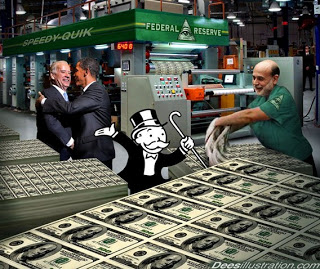 |
| Dees Illustration |
It was the night before Christmas Eve, and CNBC trucked out TrimTabs’ Charles Biderman to a de minimis audience, knowing full well that a man with his understanding of money flows would very likely repeat his statement from last year, that there is no real, valid explanation for the inexorable move in stocks higher, as equity money flows in 2010 were decidedly negative, and any explanation of the upward melt up would need to account for Fed intervention (and no-volume HFT offer-lifting feedback loops but that is a story for another day). A year after the first scandalous report was published, TrimTabs is sticking with its story: “If the money to boost stock prices by almost $9 trillion from the March 2009 lows did not come from the traditional players, it had to have come from somewhere else. We believe that place is the Fed.
By funneling trillions of dollars in cash to the primary dealers in exchange for debt, the Fed has given Wall Street lots of firepower to ramp up the prices of risk assets, including equities.” And, wisely, Biderman, just like Zero Hedge, asks what happens when the buying one day, some day, ends: “…stock prices will be higher by the time QE2 ends, but economic growth will not be sustainable without massive government support. Then even more QE will be needed, and stock prices could keep rising for a while. In our opinion, however, no amount of QE will be able to keep the current stock market bubble from bursting eventually.” Ergo our call earlier that Bernanke has at best +/- 150 days to assuage the market’s fear that QE2 is ending (not to mention that we have a huge economic recovery, right Jan Hatzius? We don’t need no stinking QE…). Therefore the best Bernanke can hope for is to buy some additional time. At the end of the day, the biggest problem is that the massive slack in the economy means that LSAP will have to continue for a long, long time, before the virtuous circle of self-sustaining growth can even hope to take over. By then bond yields may very well be high enough that Ron Paul will demand someone finally bring Paul Volcker out of the fridge.
From TrimTabs:
What Source of Money Is Pushing U.S. Stock Prices Higher? Market Cap Rises $2 Trillion in 2010 as Buying by Companies and Foreigners Offsets Selling by Pension Funds and Retail Investors. However All of Gain and Then Some, $2.4 Trillion, Since QE2 Announced at End of August.
At the end of 2009, we published a report entitled, “Are Federal Reserve and U.S. Government Rigging Stock Market?” We questioned whether the Fed or the Treasury were pushing up stock prices because we could not identify the source of the money that pushed the market cap up by nearly $7 trillion from mid-March 2009 through December 2009.


Be the first to comment on "No Amount of QE Will Keep the Stock Market Bubble From Bursting"